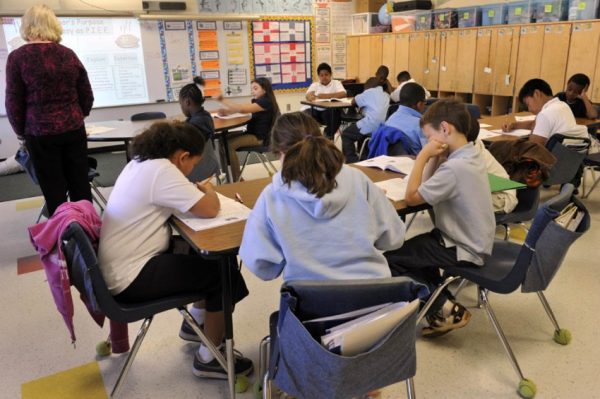Angst over Common Core test scores misses the point

Since 2012-2013 test results were released Nov. 7 there has been a flurry of publicity about the Common Core standards.
The Charlotte Observer has had strong coverage of the topic, as has the News & Observer of Raleigh. (Example: “Common Core essential to student growth,” a commentary by Superintendents Heath Morrison of Charlotte-Mecklenburg Schools and Mark Edwards of the Mooresville Graded School District, which displays a strong conceptual understanding of the need for common core standards.)
While parents, school administrators and politicians have weighed in, comments from educators have been largely absent. This is probably because the challenges of Common Core are old news for classroom teachers. Teacher professional development for the new standards began in 2010, and most N.C. teachers were expected to integrate the new standards into the previous N.C. Standard Course of Study Standards in 2011, with full adoption in 2012.
Most of the commentary about Common Core has been about the assessments, rather than the curriculum and instruction—which misses the point of why the standards were adopted. Our standards were low, and didn’t meet the needs of our workforce. The tests the state used before the 2012-2013 school year had been used for almost a decade. They had been tested and retested and had become reliable instruments. The new assessments are not.
In fact, the consortium that designed the tests is still finalizing the details of the policy manual, the manual that tells teachers how to administer the tests to their students. This is particularly relevant for students who have special needs such as English-language learners.[1]
To focus only on the test results is to miss the opportunity Common Core offers. We are not measuring the same knowledge in a new way, we have changed the paradigm. We are teaching new content, new ways of thinking, with new instructional tools and strategies.
The results are interesting data, to be sure. They point out large areas of potential growth that schools should be aware of, but they give us little new information. We can already identify schools with low academic performance. We know the schools with high achievement. We know students lack critical thinking and problem-solving skills (which the new assessments do a much better job of measuring).
We know that our school district has a problem with the achievement gap. Every district does. We don’t need test scores to show us this. The correlation between students who live in poverty and low student achievement is so strong, that the picture is the same, whether we are looking at our old tests or our new tests.
Yes, these new assessments are rigorous. For instance, the math section is mostly word problems, and unlike previous tests, at the elementary level the math section cannot be read aloud and there is no retest option. This is a large departure from previous years when students were allowed to retest if they did not pass on the first try and math sections were read aloud – which prevented the math test from being a second reading test. Just from these changes alone, scores would have gone down.
However, the tests cannot be looked at as the same measuring stick the schools have used previously. They are trying to measure the results of a new way of teaching and learning, and since they are new tests, they cannot be relied upon or compared to the tests in the past.
That’s why we should see these new results as interesting, and certainly a call to action to support schools, teachers, and learning – but should we be up in arms? No. The tests are not valid, reliable measures of academic achievement. Yet.
At a MeckED-sponsored public forum on Common Core on Nov. 14, Heath Morrison, the CMS superintendent, used an analogy we all remember from school, the 1-mile run. The previous tests measured our students’ ability to run a mile on a flat track, all within 5 minutes. Now, he said, all students are expected to do that same run, in less time, on an all-terrain track.
Extending the analogy, I’d add that we are not only asking students to run, but to add a CrossFit-style workout, complete with pull-ups, squats and push-ups, using muscles they didn’t know existed. And because the standards are new, and our middle school and high school students have been taught in a completely different way for most of their schooling, I would argue that older students are doing this new workout course without proper footwear. They are being asked to learn and think within a completely new paradigm, and then demonstrate mastery on a completely new test.
We can all agree—parents, teachers, politicians and pundits alike—that our course needed to be altered. Our standards were a low bar. We needed to broaden the teaching methods and concepts offered our students in order to better serve them, so they can achieve their potential for individual success and the success of our community.
But we have to realize that one round of test results is not an indictment of our schools, our teachers, or our children. They are just … test results.
Amy Hawn Nelson is director of the Institute for Social Capital at the UNC Charlotte Urban Institute, and has a Ph.D. in curriculum and instruction from UNC Charlotte. Opinions expressed here are those of the author and not necessarily those of the UNC Charlotte Urban Institute or the University of North Carolina at Charlotte.
[1] See Sept. 18, 2013, Education Week, Consortium Approves Common-Core Test Supports